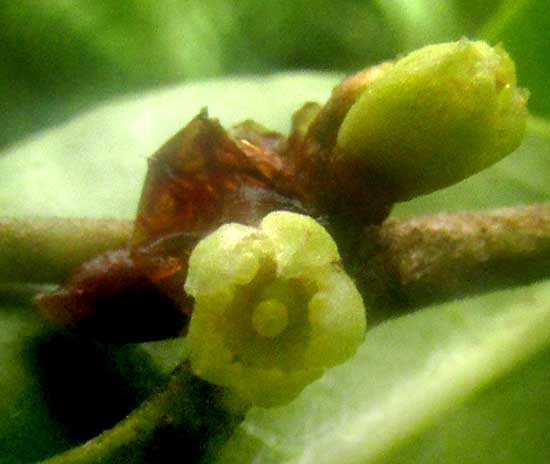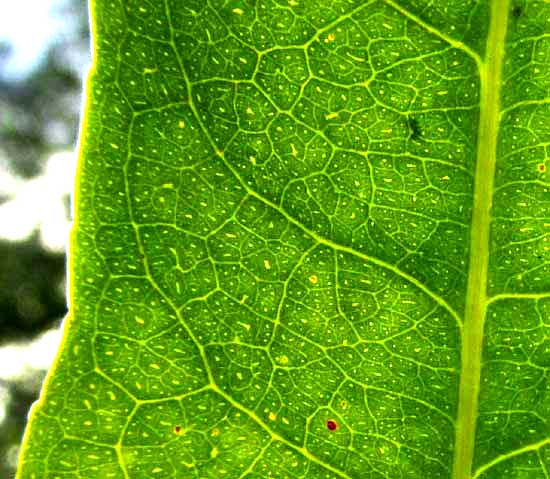Excerpts from Jim Conrad's
Naturalist Newsletter
from the September 14, 2018 Newsletter issued from Rancho Regenesis in the woods ±4kms west of Ek Balam Ruins; elevation ~40m (~130 ft), N~20.876°, W~88.170°; central Yucatán, MÉXICO
THE NARROWLY ENDEMIC CASEARIA SUBSESSILIFLORA
Beside the trail through scrubby forest leading to the rancho, a small tree bore small clusters of greenish-white, unusually tiny flowers, as seen below:

The flowers were so diminutive that I doubted my camera could provide much service, but with the help of Photoshop I did manage the image shown below:

In the center of the picture's bottom blossom we see a spherical stigma head, and below that the ovary. It looks like the ovary is surrounded at its base by a swollen disk, and I think I see more than five stamens.
That wasn't much information to go on, but the exceptionally small flowers and the leaves' weakly scalloped, or "crenate," margins reminded me of a commonly occurring tree here, Casearia corymbosa of the tropical Flacourtia Family, our page for which is at www.backyardnature.net/yucatan/casearia.htm
On that page we see that a very interesting feature of the Casearia genus is that its leaves, when held against the Sun, display between their veins many bright dots and streaks. Several plant families display such dots -- the Citrus Family (Rutaceae) and the Myrtle Family (Myrtaceae) foremost among them. However, those streaks are extraordinary. Botanists say that such translucing entities are "pellucid." This pellucid dotting and streaking is fairly common in the Flacourtia Family, so I held one of our trail leaves against the sun and saw what's shown below:

This leaf's pellucid streaks aren't as long as those in Casearia corymbosa leaves, but they're present amid all those dots. The trail tree's leaves are much smaller and narrower than those of Casearia corymbosa so I wondered if this might be a second Casearia species.
And, sure enough, a second species is listed for the Yucatan. It's CASEARIA SUBSESSILIFLORA, in the whole world occurring only in the Yucatan Peninsula, and only in a limited part of it. So, this was a good find.
The earlier Casearia corymbosa apparently is graced by no English name, and this much lesser known species doesn't have one, either. Even the local experts can't find a Spanish or Maya name for it, and I can find no further information about it at all on the Internet. In fact, I can find no close-up pictures of the flower, so maybe ours will help future experts. Casearia corymbosa is listed as "needing attention" with regards to its vulnerability to extinction, as would be any species with such a small distribution in an area constantly being slashed-and-burned.